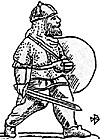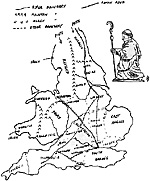 Writing about King Arthur has become something of an industry in its own right over recent years. It seems that every month, when my book club catalogues drop on the doormat, I'll be presented with any number of new books about Britain's greatest hero. These books seem to fall into two camps; one group focuses on the legendary and mythological aspects of the Arthurian legend: the Holy Grail, the Sword in the Stone, etc; the other strain concentrates on the search for the historical Arthur behind the legends.
Writing about King Arthur has become something of an industry in its own right over recent years. It seems that every month, when my book club catalogues drop on the doormat, I'll be presented with any number of new books about Britain's greatest hero. These books seem to fall into two camps; one group focuses on the legendary and mythological aspects of the Arthurian legend: the Holy Grail, the Sword in the Stone, etc; the other strain concentrates on the search for the historical Arthur behind the legends.
Here there is little agreement. Some authors, for example, argue convincingly that there was no REAL Arthur, and that there is no truth at all behind the legends. Conversely, Geoffrey Ashe placed Arthur in Brittany, leading an army out of Armorica against the Franks. Skene placed all Arthur's battles within Scotland. Others place Arthur in the West Country. The same evidence is used by all these historians to prove their diverse theories.
Now, I am not a professional historian, able to lend any weight to the learned argument, and the following game is simply based on my favourite version of the "true" story of King Arthur!
THE HISTORICAL CONTEXT
The last Roman legion was withdrawn from Britain in 407 AD, after almost 400 years of control, leaving the Romanized British in a sort of culture shock. Some degree of "Roman-ness" remained, however, and much social and military administration was to stay on Roman lines for some considerable time, run by Britons who had known no other way. Meanwhile, the Kings of the old royal houses, which had always been part of Roman administration in Britain, jostled to regain the status their ancestors had enjoyed before the Romans arrived. The whole of the Western Roman empire was under pressure from the East as whole peoples: the Goths, Franks, Saxons, etc, migrated westwards. Britain, along with other ex-Roman provinces, struggled to keep these barbarians out. The chap who invited the first Saxons to Britain to aid the defenders is known to us as Vortigern, though this may be his job description rather than his given name (Vawr Tighern = overlord).
This decision is often presented as foolish, but Vortigern would have been familiar with the Roman use of such foederati in their armies and could not have known that his Saxon allies would eventually turn on him. The Saxons were given lands in Kent and Essex on which to settle. In time, more and more of these settlers arrived; Saxons, Angles and Jutes, until the lands they had been granted were no longer enough to hold them. Conflict with the native British became inevitable.
The British defence against the Saxon inroads was first co-ordinated by Vortigern's son, Vortipor, and later by Ambrosius Aurelianus (known as the "Last of the Romans".) After his death, the defence of Britain fell to Arthur.
No King
Arthur was not a king. His title was probably Dux Bellorum, 'Duke of Battles', a Roman title for an official charged with the defence of the province. He was tied to no particular British tribe, but had rather a 'roving commission' to go wherever his force would be needed. It is believed that Arthur must have led a highly mobile cavalry force, armed and organised along Roman lines and able to travel to trouble-spots at high speed to augment the local forces. The Britons would have understood and respected the Dux' Roman title and role and may thus have been more likely to co-operate with him.
There is good evidence (and strong local tradition) that Arthur made his base at South Cadbury, in Somerset, an ancient hill-fort which archeologists have proved was re-fortified in the late 5th or early 6th century. Cadbury is large enough to have held such a force as Arthur is said to have had and is convenient for the Roman road network.
THE CAMPAIGN
You are Arthur, Dux Bellorum, charged to aid the British kingdoms in their defence against the incursions of the English.
Make out a number of cards as follows: Two cards for each of the following British kingdoms:
- Rheged
Gwynedd
Calchvynydd
York
Glevissig
Cornovii
Dumnonia
Wroxeter
Powys
Elmet
Bernicia
One card for each of the following:
- Irish raiders from Demetia into Glevissig
Irish raiders into Rheged
Pictish raiders into Rheged
Pictish raiders into Bernicia
The campaign begins in 495AD. Each campaign year is split into 5 bounds. At the end of each year, all troops return to their winter quarters in their home kingdom. Arthur and his men return to Cadbury.
SET UP
First shuffle the cards and deal them into two piles. Choose one pile for Arthur. Leave the other pile face down. If you hold both cards for any of the British kingdoms, it can be considered a staunch ally. If you hold one card for a kingdom, you have an uneasy alliance. If you hold a raid card, you have a non-aggression treaty with the potential raiders which will prevent their attacking. At the start of any year, you can discard up to three of the cards in your pile and pick up the same number of cards from the other pile.
BOUND SEQUENCE
Moves are alternate and the English move first. A D10 is thrown each bound until an English expansion attempt is activated. (i.e. five attempts per year)
-
1. The Angles of Lindsey move North. (Into Deira, to York. To Bernicia)
2. The Angles of Lindsey move West. (Elmet. Into Rheged to Chester)
3. Middle Angles move North West. (To Wroxeter and Chester. Gwynedd)
4. Middle Angles move West. (Into Calchvynydd to Gloucester. Powys)
5. East Saxons move West. ( Into Dumnonia to Silchester and Bath.)
6. South Saxons move West. (Into Dumnonia to Winchester and Cadbury)
7 - 10. No expansion.
At the start of their move, throw a D6 for the English: 1,2 or 3, pick up one card. 4,5, pick up two cards. 6 pick up three cards.
If the English pick up a raid card, the raiding takes place.
If they have both cards for a British kingdom, it becomes an staunch ally.
If they have one card, it is an unreliable ally. (If Arthur holds the other card, this army will fight for neither side.)
Each bound that the English win (i.e. they are successful in ALL encounters in that bound), a D6 is thrown. On a 1 or 2, another English force is activated. Throw a D6 against the table above. If the same English army is activated, the original army is reinforced by the addition of a fresh army.
Once an army crosses into enemy territory, it must remain there until the defenders are overrun, or until it is itself defeated, in which case it must return to its own homeland.
DEFENDERS
If the English move into a kingdom with which they do not have an alliance, the British defenders must try to repel them. However, if they are outnumbered 3 to 1 or more, they are automatically defeated. Otherwise, resort to the tabletop to resolve the result.
In the British turn, you, as Arthur, must try to co-ordinate a defence. If you are present, your staunch allies will turn out to fight for you, but only in their own kingdom or one adjacent to it. Unreliable allies will fight in their own kingdom but will only move to an adjacent one on a throw of 5 or 6 on a D6. However, neither will leave their homeland if it is subjected to raids by the Picts or Irish.
Any kingdom (British or English) which is defeated three times in succession on its own soil, (not necessarily in succeeding bounds) is considered to be overrun and can no longer raise troops: it becomes part of the kingdom which has conquered it. When a battle is fought, all contending armies within the kingdom where it takes place will take part: Irish and Pictish raiders count as unreliable allies. An army will not fight in any other kingdom if its homeland is under attack.
THE ARMIES
Dice for the size of the respective armies when they come into contact with each other. This will depend on the numbers of troops you have available and the rules you use, so the following is just a suggestion. So long as the proportions are similar, feel free to tinker with the details.
For an English army: to DBM: 300 pts +/- D6 x 30 pts.(i.e. black die plus, red die minus) to WRG 7th, 700 pts +/- D6 x 75pts.
For British army: to DBM: 125 pts +/- D6 x 30 pts. to WRG 7th. 300 pts +/- D6 x 75pts.
For raiders: to DBM: 100 pts +/- D6 x 30 pts to WRG 7th: 250 pts +/- D6 x 75 pts.
Arthur has 100 pts (DBM) or 225 pts (7th) of cavalry.
After a defeat, deduct all troops killed or routed in the battle. When next in action, add D6 x 30 or 75 pts to simulate recruitment or fugitives straggling back to the ranks.
MOVEMENT
All armies may move from one kingdom into an adjacent one in one bound. Arthur, however, may move as far as wished on the Roman road network, providing he does not cross enemy territory. If he reaches enemy territory, he may stop at the border or cross and engage the defenders.
CONCLUSION
As you can guess, this campaign can soon degenerate into a free-for-all, with Arthur rushing hither and thither to the danger points to stem the English advance. The British kingdoms, if they fight alone, are soon overrun, so Arthur must be on hand to stimulate some level of co-operation between them. Of course, if you have a knot of staunch allies, you could launch a "pre-emptive strike" on one of the English homelands. If you are fighting on English territory, any adjacent English armies may join in on a throw of 1 on a D6 per bound.
Good luck in your attempt to keep the English out of Britain! Of course, if you fail, you can always go to Avalon to regain your strength for another go!
RECOMMENDED READING
So many to choose from!
The Age of Arthur by John Morris. (A lot of reading, but a very highly recommended account of the whole post-Roman period)
Warriors of Arthur by Matthews & Stewart (Everyone interested in Arthur must have read this one!)
King Arthur, a Military History by Michael Holmes. (Plausible account of one version of Arthur's history.)
Map of Arthur's Britain

Back to Table of Contents -- Lone Warrior #121
Back to Lone Warrior List of Issues
Back to MagWeb Magazine List
© Copyright 1998 by Solo Wargamers Association.
This article appears in MagWeb (Magazine Web) on the Internet World Wide Web.
Other military history articles and gaming articles are available at http://www.magweb.com
